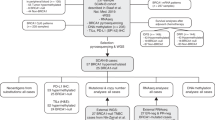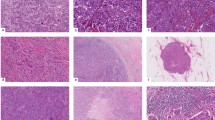Abstract
Cancer development is related not only to genetic alterations but also to aberrant epigenetic changes that could lead to heritable gene patterns critical for neoplastic initiation and progression. Knowledge of epigenetic regulation in cancer cells is useful for both the understanding of carcinogenesis and for the possibility of using epigenetic drugs. HOX genes deregulation have a crucial role in oncogenesis process and tumor suppression. In this report, the methylation of HOXA1, HOXA9, HOXA10, HOXB13, HNF1B, OTX1, TLX1 genes have been analyzed in patients with hereditary breast cancer. This is the first study analyzing BRCA mutational status of patients with respect to methylation of HOX genes. HOXA10 has been found to be methylated in all patients analyzed but never in healthy subjects. With respect to clinical pathological information, hypermethylation of all studied genes, with the exception of OTX1, was significantly associated with absence of HER2 neu expression (P<0.05). Moreover, hypermethylation of HOXB13, HOXA10 and HOXA1 was associated with a high proliferation index (Mib1⩾10%, P<0.05) and hypermethylation of HOXB13 and HOXA10 also with high expression of estrogen and progesterone receptors. These preliminary data suggest a possible involvement of HOX genes in familial breast cancer as marker helpful to identify high-risk patients.
Similar content being viewed by others
Main
HOX genes have a crucial role not only in development, receptor signaling, differentiation, motility and angiogenesis, but also in apoptosis; thus, alterations in their expression could have a role in both oncogenesis and tumor suppression and, consequently, in diagnosis and therapy. In particular, HOX gene methylation is atypical in breast cancer tissue compared with normal epithelia1 and is linked to malignant transformation and tumor aggressiveness.2
The aim of this study was to analyze the methylation status of a group of HOX genes in familial breast cancer to understand a possible role of their epigenetic regulation with respect to BRCA1-2 mutational status. In fact, it is already known that HOXA9 overexpression slows breast cancer progression, binding the 5′ promoter region of BRCA1 then modulating its expression.2 For this reason, methylation of the regulatory genes HOXA1, HOXA9, HOXA10, HOXB13, HNF1B, OTX1, TLX1 has been investigated in high-risk subjects with a familial history of hereditary breast and/or ovarian cancer, with these genes resulting highly involved in breast cancer.3, 4 This is the first study analyzing BRCA mutational status with respect to methylation of HOX genes in hereditary breast cancer subjects.
A total of 24 subjects (19 breast cancer affected and 5 healthy relatives from high-risk familial breast cancer) coming from the genetic counseling program of the National Cancer Research Centre of Bari, and a pool of 9 healthy unrelated controls without breast cancer were enrolled. Among the group of 24, subjects #10, #11, #12, #13 and #20 were healthy, BRCA mutated and with a strong history of breast cancer, whereas patients #3, #8 and #23 also had ovarian cancer.
All subjects were tested by the Methyl-Profiler DNA methylation PCR System (Qiagen GmbH, Hilden, Germany) for the methylation status of HOX genes mentioned above. The method was based on the detection of remaining input DNA after cleavage with a methylation-sensitive enzyme and/or a methylation-dependent restriction enzyme and quantified by real-time PCR. All subjects were analyzed for BRCA1 and BRCA2 mutational status5 and all molecular and clinical pathological information is reported in Table 1.
Healthy controls were unmethylated in all the investigated genes.
The tests highlighted a hypermethylation of the HOXA10 gene in all high-risk subjects. Silencing of TLX1, OTX1, HOXA9, HOXA1 and HNF1B genes by methylation has been found to be significantly associated with BRCA mutational status considering both patients and healthy subjects with a high risk of familial breast cancer history (P=0.01) (Table 2). Hypermethylation of all studied genes, with the exception of OTX1, was significantly associated with absence of HER2 neu expression (P<0.05). Moreover, hypermethylation of HOXB13, HOXA10 and HOXA1 was associated with a high proliferation index (Mib1⩾10%, P<0.05) and hypermethylation of HOXB13 and HOXA10 also with high expression of estrogen and progesterone receptors.
The goal of this study was to analyze the HOX gene methylation in heredo-familial breast cancer, particularly focusing on the possibility to use them as susceptibility markers in subjects with a high risk of hereditary breast cancer but without BRCA1 and BRCA2 mutations. This is the first experimental approach analyzing HOX gene methylation in patients with a strong familial history of breast/ovarian cancer compared with BRCA1/2 mutational status.
All previous published studies show that HOX genes are misregulated in cancer, but the role of their hypomethylation or hypermethylation is not clear.6
In this series, HOXA10 resulted in hypermethylation in all high-risk subjects, affected and not, with no differences between mutated and non-mutated cases, whereas all healthy controls were unmethylated, thus assuming a possible role of this gene as a susceptibility marker in BRCAX (without mutations in BRCA1 and BRCA2 genes) patients. HOXA10 was reported to regulate p53 expression and invasion in breast tumor cells7 and to be lower expressed in breast tumors compared with normal tissue;8 however, no data were available on HOXA10 expression and familiarity.
Previous studies showed an association between HOX gene methylation and immunophenotypes showing a close association between HOXA1 and HOXA10 methylation and infiltrating ductal carcinoma (IDC). In this series, all cases analyzed were IDC, confirming the behavior of HOXA10. Regarding HOXA1, Park et al.9 showed how HOXA1 hypomethylation resulted significantly present in basal-like tumours apparently in contrast with the association between BRCA mutations and hypermethylation of TLX1, OTX1, HOXA9, HOXA1 and HNF1B described here. Currently, only 37.5% of BRCA1 mutated cases are triple-negative breast cancer and we do not have any information on other markers characterizing basal-like tumors (Table 1).
The significant silencing of HOXB13 and HOXA10 in ER- and PgR-positive tumors confirmed promoter hypermethylation of HOXB13 more frequently observed in ERa-positive patients10 and regulation of HOXA10 by the complex E2-ER and its modulation by ERE elements.11
No previous data have been published about the correlation between methylation status of HOX genes and proliferative activity (Mib1 expression) or HER2 neu expression here described.
OTX1 has been shown to be regulated by p53 only in cancer stem cells but not in physiological conditions, while the interaction of these two genes is involved in the differentiation of cancer stem cells as a tumor suppression mechanism.12
Three patients also presented ovarian cancer but, being only a few cases, no peculiar characteristics on methylation pattern emerged. Kelly et al.13 reviewed different studies about the HOX gene behavior in ovarian cancer. Furthermore, HOXB13 has been demonstrated to induce ovarian cancer progression but also to be a functional regulator of antihormonal resistance in human ovarian cancer.14
In the present report, the authors hypothesized that the analysis of methylation status of HOX genes in familial breast and/or ovarian cancer could be a milestone to individuate novel markers in this series of selected patients. The reported preliminary data, in fact, highlighted the involvement of HOXA10 gene inactivation as a marker of familial breast cancer. Furthermore, association between specific HOX gene methylation and BRCA mutations and histopathology and clinical aggressiveness parameters suggest the possibility of identifying patients at higher risk.
Many questions remain still unclear and other studies will be necessary to confirm our data and clearly define the role of HOX gene inactivation in the hereditary breast cancer phenotype.
References
Samuel, S. & Naora, H. Homeobox gene expression in cancer: insights from developmental regulation and deregulation. Eur. J. Cancer 41, 2428–2437 (2005).
Gilbert, P. M., Mouw, J. K., Unger, M. A., Lakins, J. N., Gbegnon, M. K., Clemmer, V. B. et al. HOXA9 regulates BRCA1 expression to modulate human breast tumor phenotype. J. Clin. Invest. 120, 1535–1550 (2010).
Tommasi, S., Karm, D. L., Wu, X., Yen, Y. & Pfeifer, G. P. Methylation of homeobox genes is a frequent and early epigenetic event in breast cancer. Breast Cancer Res. 11, R14 (2009).
Avraham, A., Sandbank, J., Yarom, N., Shalom, A., Karni, T., Pappo, I. et al. A similar cell-specific pattern of HOXA methylation in normal and in cancer tissues. Epigenetics 5, 41–46 (2010).
Tommasi, S., Pilato, B., Pinto, R., Monaco, A., Bruno, M., Campana, M. et al. Molecular and in silico analysis of BRCA1 and BRCA2 variants. Mutat. Res. 644, 64–70 (2008).
Abate-Shen, C. Deregulated homeobox gene expression in cancer: cause or consequence? Nat. Rev. Cancer 2, 777–785 (2002).
Chu, M. C., Selam, F. B. & Taylor, H. S. HOXA10 regulates p53 expression and matrigel invasion in human breast cancer cells. Cancer Biol. Ther. 3, 568–572 (2004).
Novak, P., Jensen, T., Oshiro, M. M., Wozniak, R. J., Nouzova, M., Watts, G. S. et al. Epigenetic inactivation of the HOXA gene cluster in breast cancer. Cancer Res. 66, 10664–10670 (2006).
Park, S. Y., Kwon, H. J., Lee, H. E., Ryu, H. S., Kim, S. W., Kim, J. H. et al. Promoter CpG island hypermethylation during breast cancer progression. Virchows Archiv 458, 73–84 (2011).
Rodriguez, B. A., Cheng, A. S., Yan, P. S., Potter, D., Agosto-Perez, F. J., Shapiro, C. L. et al. Epigenetic repression of the estrogen-regulated Homeobox B13 gene in breast cancer. Carcinogenesis 29, 1459–1465 (2008).
Martin, R., Taylor, M. B., Krikun, G., Lockwood, C., Akbas, G. E. & Taylor, H. S. Differential cell-specific modulation of HOXA10 by estrogen and specificity protein 1 response elements. J. Clin. Endocrinol. Metab. 92, 1920–1926 (2007).
Terrinoni, A., Pagani, I. S., Zucchi, I., Chiaravalli, A. M., Serra, V., Rovera, F. et al. OTX1 expression in breast cancer is regulated by p53. Oncogene 30, 3096–3103 (2011).
Kelly, Z. L., Michael, A., Butler-Manuel, S., Pandha, H. S. & Morgan, R. G. HOX genes in ovarian cancer. J. Ovarian Res. 4, 16 (2011).
Miao, J., Wang, Z., Provencher, H., Muir, B., Dahiya, S., Carney, E. et al. HOXB13 promotes ovarian cancer progression. Proc. Natl Acad. Sci. USA 104, 17093–17098 (2007).
Acknowledgements
We thank Dr Caroline Oakley for language revision. This work is partially supported by Progetto Regione Puglia DIEF 2007.
Author information
Authors and Affiliations
Corresponding author
Ethics declarations
Competing interests
The authors declare no conflict of interest.
Rights and permissions
About this article
Cite this article
Pilato, B., Pinto, R., De Summa, S. et al. HOX gene methylation status analysis in patients with hereditary breast cancer. J Hum Genet 58, 51–53 (2013). https://doi.org/10.1038/jhg.2012.118
Received:
Accepted:
Published:
Issue Date:
DOI: https://doi.org/10.1038/jhg.2012.118
Keywords
This article is cited by
-
Screening and identifying of biomarkers in early colorectal cancer and adenoma based on genome-wide methylation profiles
World Journal of Surgical Oncology (2023)
-
Meta-analysis of integrated ChIP-seq and transcriptome data revealed genomic regions affected by estrogen receptor alpha in breast cancer
BMC Medical Genomics (2023)
-
Noninvasive detection of pancreatic ductal adenocarcinoma using the methylation signature of circulating tumour DNA
BMC Medicine (2022)
-
Chicken cecal DNA methylome alteration in the response to Salmonella enterica serovar Enteritidis inoculation
BMC Genomics (2020)
-
Non-invasive early detection of cancer four years before conventional diagnosis using a blood test
Nature Communications (2020)



